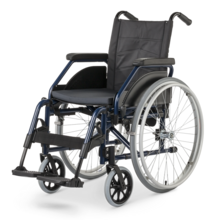Brain injury caused by trauma to the brain or skull. Depending on the severity, this results in the partial or total loss of bodily functions. This especially affects motor skills (spastic tetraparesis or hemiparesis) and aesthesia along with various forms of perception and the ability to communicate with one's environment. Oral food intake is either impossible or only possible with limitations. The autonomic nervous system (blood circulation, breathing, bladder and colon function) is also impaired. The extent of the impairment is influenced by the length of the initial state of unconsciousness (coma) and is also dependent on the age of the person in question.
Wheelchair requirements
- The front section of the frame must be straight and the legrests must be able to swing-away and be removable to allow for active transfer from the front (possibly via a standing position)
- The wheelchair must have a very stable construction due to frequently occurring spasticity
- Supporting seat elements and accessories (headrest, height-adjustable side guards, therapy table, etc.) for the initial movement from a lying into a sitting position
- Seat and back systems and accessories must ensure individual adjustment to functional restrictions (e.g. remaining mobility, limited strength, torso stability)
- Distinct, easily recognisable and robust controls for independent handling
- Poor posture should be avoided
- The wheelchair should have a stimulative character that encourages independent activity
- The mobility and active manoeuvrability of persons with less severe conditions must be supported
- Different seat heights for "wheelchair movement"
- A cushion that prevents bedsores is usually required, because most users cannot independently relieve strain while sitting
- Functions that the carer can operate with one hand in order to keep one hand free for the patient





